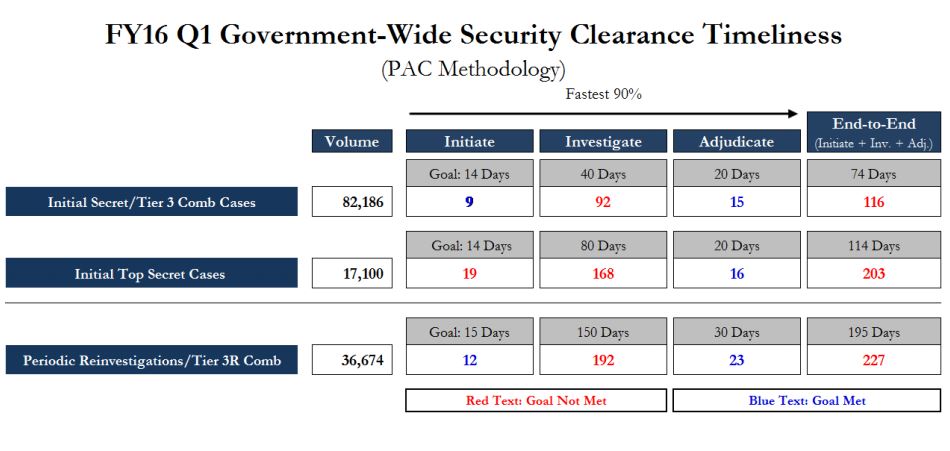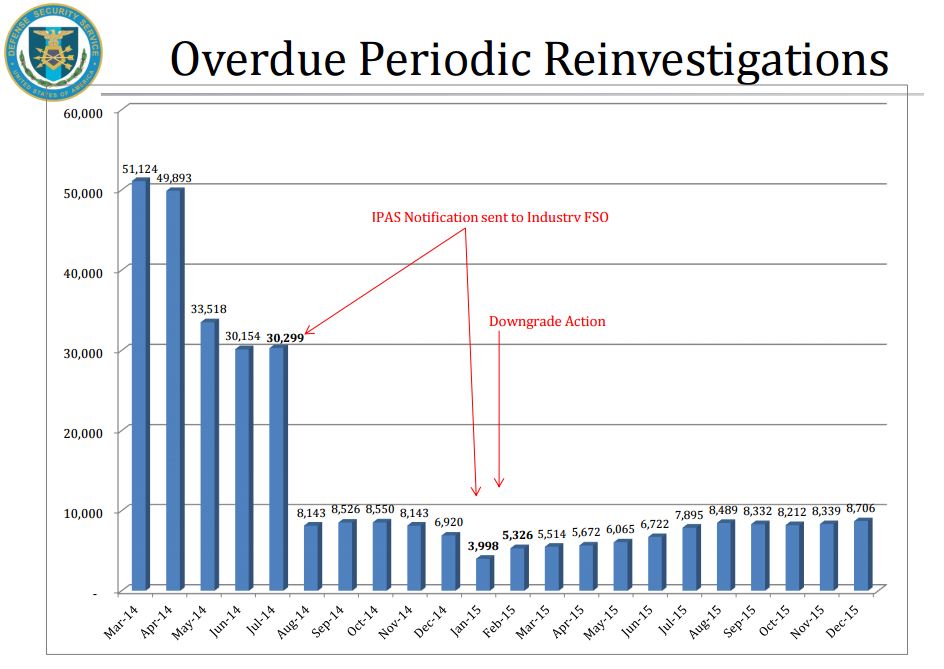
Periodic reinvestigation backlog more than doubled in 2015
The investigations process is to blame for higher security clearance processing times at the beginning of 2016 and end of 2015. Challenges with culture, resources...
Processing times for security clearances and periodic reinvestigations reached new highs at the end of the fiscal 2015, and initial reports show those times are not improving quickly.
According to a first-quarter update to Performance.gov, initial secret/Tier 3 comb cases took an average of 116 days to process in the beginning of 2016, compared to a 95-day average at the end of 2015. Initial top secret cases took an average of 203 in 2016 so far, compared to a 179-day average by the end of last year.
Periodic reinvestigations took an average of 227 days, better than the 251 day average the administration reported in 2015.
The investigation process is generally holding up the administration from meeting its goals to process applications. But the administration met all of its goals to adjudicate those cases once it finished the investigations.

The number of overdue periodic reinvestigations dropped drastically since the Obama administration ordered agencies in 2014 to scale back their lists of cleared federal employees and contractors who needed access to classified and top secret information.
Agencies started 2015 with 3,998 overdue reinvestigations — a new low from the previous years and even months. But that number more than doubled by the end of 2015 with 8,706 overdue reinvestigations — the highest it’s been since July 2014’s backlog of 30,299 cases.

The Office of Personnel Management and the Office of the Director of National Intelligence took the Electronic Questionnaires for Investigations Processing (e-QIP) system offline in July for cybersecurity fixes, which may likely explain the steady rise in backlogged cases.
This comes as the administration is in the beginning stages of a massive overhaul to the federal security clearance process. The Office of Management and Budget and OPM are standing up the National Background Investigations Bureau (NBIB) and are beginning to discuss how they will transfer current clearance operations from the old agency, Federal Investigative Services, to the new organization.
Insider threat, social media programs falling farther behind
Challenges with culture, resources and legal questions are pushing agencies farther and farther off schedule in standing up their own insider threat programs.
Most departments have met the basic requirements, but many still haven’t, according to a first-quarter update to Performance.gov. The National Insider Threat Task Force (NITTF) is working “to address those issues as quickly as possible.”
Agencies were supposed set up the basic requirements for their programs by January 2015 and achieve initial operating capability by December 2015.
ODNI is still working on a governmentwide continuous evaluation (CE) capability, which the ODNI will implement in phases, the update said. The goal is to complete CE for part of the TS or TS/SCI population by the end of fiscal 2016.
But the Defense Department expanded its continuous evaluation capabilities to 225,000 personnel at the end of the 2015, and it appears on track to use CE for 500,000 and 1 million people by 2016 and 2017, respectively.
The administration is also behind schedule in adding two new, long-discussed changes to information-sharing for its insider threat and security clearance programs.
Agencies are still waiting for the go-ahead to begin using social media in their security clearance reviews, because the ODNI has not released its Security Executive Agent Directive (SEAD) for publicly available electronic information. The deadline was in December 2014, but the ODNI finished reviewing the first round of comments that agencies submitted in July 2015, the update said.
The administration is also still deciding how it will incorporate questions of mental health into its investigations. The Mental Health Working Group is continuing its conversations to discuss “the intersection of mental health issues and suitability and security reporting,” the update said.
Copyright © 2025 Federal News Network. All rights reserved. This website is not intended for users located within the European Economic Area.
Nicole Ogrysko is a reporter for Federal News Network focusing on the federal workforce and federal pay and benefits.
Follow @nogryskoWFED
Related Stories






